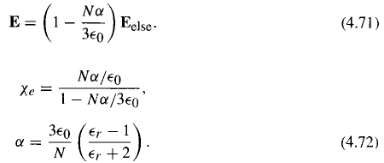In a linear dielectric, the polarization is proportional to the field: P = 0XeE. If the material
Question:
In a linear dielectric, the polarization is proportional to the field: P = ε0XeE. If the material consists of atoms (or nonpolar molecules), the induced dipole moment of each one is likewise proportional to the field p = aE. Question. What is the relation between the atomic polarizability a and the susceptibility Xe? Since P (the dipole moment per unit volume) is p (the dipole moment per atom) times N (the number of atoms per unit volume), P = Np = NaE, one's first inclination is to say that Xe = Na/ε =. (4.70) And in fact this is not far off, if the density is low. But closer inspection reveals a subtle problem, for the field E in Eq. 4.30 is the total macroscopic field in the medium, whereas the field in Eq. 4.1 is due to everything except the particular atom under consideration (polarizability was defined for an isolated atom subject to a specified external field); call this field Eelse. Imagine that the space allotted to each atom is a sphere of radius R, and show that Use this to conclude that or Equation 4.72 is known as the Clausius-Mossotti formula, or, in its application to optics, the Lorentz-Lorenz equation.

Step by Step Answer:






